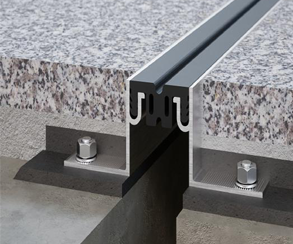

Nexus Expansion Joint Solution
Nexus Expansion Joint Solutions offer a comprehensive ranges of durable Expansion Joint Solutions for a wide array of applications including commercial centers, shopping malls, railway stations, airports, shopping centers, bridges, schools, hospitals, and several other areas of application.
Our range of Expansion Joint Solutions are designed to safely absorb the heat-induced expansion and contraction of concrete slabs, to absorb vibration, and to allow movement due to ground settlement or earthquakes. Our variety of expansion joints includes profiles for walls and floor, for pedestrian as well as heavy loads traffic, for seismic movements, and several other uses. Nexus Expansion Joint Solutions include aluminum profiles, rubber profiles, and a combination of aluminum profiles with rubber inserts.
Nexus Expansion Joint Solutions, designed to conceal areas of structural movement. Concrete Slabs are designed to move due of pressures from long-term shrinkage, thermal expansion, contraction of the structure and seismic activity.
Our floor expansion joint systems are suitable for applications with joint openings of several width, and up to 400 mm. Our Expansion Joint Solutions require minimum maintenance works throughout the year.
Selection Criteria for Expansion Joint Solutions Movement
When designing the building, there are three main types of movement to consider: thermal, seismic and wind sway.
• Thermal:
Changes in temperature cause buildings to expand and contract which can leave broken flooring components resulting in damage to the building structure and design.
• Seismic:Earthquakes and seismic events cause movement and swaying for the architectural structure. Larger joint widths are suitable for buildings that are located in seismic zones.
Wind Sway:Tall buildings and structures with a large surface area are affected by wind sway that pushes against the building and causes tilt or swaying motions.
Expansion Joints plays a vital role in safeguarding these buildings by permitting the structure to absorb these movements.
Loading requirements
Pedestrian, Assorted and Solid Heavy Duty Expansion Joint Solutions are designations as they relate to load ratings. It is a guideline that assists in choosing a proper profile for the specified application a preliminary product selection for a given application.
• Pedestrian Profiles:
Used in common applications where pedestrian traffic, rubber-wheeled traffic and light-weight cleaning equipment exists.
• Assorted Profiles:These profiles suggest applications which is subject to mixed loads from Pedestrian to relatively light weighted vehicular loads such as motorcycles, light weight internal use electric cars, light duty forklifts, motorized cleaning equipment and vehicles of akin loads. The systems in this category are comprised of heavier aluminum extrusions, with thicker walled extruded rubber inserts.
• Solid Heavy Duty Profiles:Solid Heavy Duty Expansion Joint Solutions for applications where truly heavy loads, such as vehicles, forklifts, Pickups and high-point loads are the norm. These heavy-duty profiles are capable of handling loads of up to 7 tons. They are capable of multi-directional movements and are also available in surface or block out mounted variations.